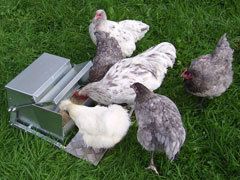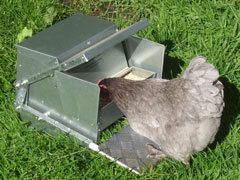Quote:
Yes! Big capacity! (See Question 28 in FAQ's below.) Here's some pix of a galvanized treadle feeder made by a New Zealand company going for mucho bucks:
With your skills and OCD about chickens
(me, too), you could make a MUCH cheaper wooden one just as bulletproof.
Here's the FAQ's on the galvanized feeder with lots of info on dimensions you can "borrow" (
http://www.grandpasfeeders.com/index.php?option=com_content&view=article&id=34 ):
1.
Are the feeders guaranteed? Yes, they come with a 6 month, full satisfaction money back guarantee. Be assured this will probably be one of the best things you will have ever bought, as is told to us by many of our customers.
2.
How can we pay? We accept credit cards and cheques.
3.
Do you have an agent in our area? No, we only sell direct from our distributor in Griffin (near Atlanta, Georgia).
4.
How long to deliver? - Allow up to 7 days.
5.
How are they sent out? Via FedEx
6.
Will the feeder fit in the car? - Yes, The carton dimensions are: standard feeder 300 x 390 x 440mm, large feeder 410 x 450 x 560mm.
7.
How heavy are they? A standard feeder is 15lb and a large feeder is 20lb.
8.
What are they made of? Galvanized steel and alloy tread plate
9.
Is it water proof? Yes.
10.
Does it come assembled? Only the tread plate has been removed for shipping and is easily attached with 4 bolts that are provided.
11.
Are they a proven product? Absolutely. Since Grandpa designed and developed these feeders in New Zealand 14 years ago, many thousands have been sold and are now considered standard equipment for anyone keeping poultry. We have many customers who have feeders they bought 14 years ago and which are still working faultlessly today after 14 years continual use outside and exposed to the elements.
12.
How does it work? The hen steps on the tread plate and their weight opens the feeders lid, giving access to the food and the lid closes when the hen steps off.
13.
Will my chickens overeat? No, egg laying hens will only eat what they need, the more they eat the more they lay.
14.
Where can the feeders be placed? Anywhere inside or out, as long as the feeder is on a flat surface extending to the front of the tread plate.
15.
a). What weight is required to open the feeder? A standard feeder requires 14oz and a large feeder requires 2lb (an adult rat weighs 9 to 11oz)
b). What weight is a chicken? - An average hen is around 4.5lb and bantams around 1.5lb.
16.
How many chickens are needed to open the feeder? It only takes one chicken or bantam to open the standard feeder, however one bantam by itself is not heavy enough to open the large feeder.
17.
What age can they use it? - They can use it once they are of an age to be heavy enough. However, we recommend that baby chickens are not allowed access as they can be caught by the closing lid as a larger bird steps off.
18.
Can one small chicken/bantam open the feeder? - For very light birds or bantams which are too light for the feeder, it is very easy to adjust the feeder by putting a small weight on the tread plate. (Do not use with baby chickens, see question 18).
19.
a). Will my hens learn to use it? Yes.
b). How do you train poultry to use them? The feeders come with 2 training bolts to limit movement and instructions for their use. There are 2 settings with one week on each setting.
20.
How far does the platform extend out from the main feeder? Standard feeder 7.5", large feeder 9".
21.
How many chickens can feed at once? A Standard feeder can feed 3-4 chickens at once and a large feeder 4-5.
22.
Is the large feeder too high for small chickens/bantams? No
23.
How long will the food last? A standard feeder for 6 hens will last 10 days and a large feeder for 12 hens will last 10 days.
24.
Do they fight over the food? No, even a bossy hen will not be at the feeder for very long.
25.
What happens when getting new chickens? The new one will learn from the existing flock, but you must repeat the training program with a completely new group.
26.
What type of feed can be used in them? They are suitable for all dry feeds. However, we recommend not using a mix of feeds as the chickens often flick food out when looking for their preferred morsels.
27.
Can their heads get caught? No.
28.
What size feeder do I need? We have customers feeding over 80 chickens with one large feeder and over 40 with the standard feeder. We suggest the large feeder is better suited for 10 or more, so you are not required to constantly fill the feeder.
29.
Can ducks, geese and turkeys use them? Yes, the larger feeder is suitable, although it may be necessary to extend the tread plate out for bigger birds. This can be done very easily.
30.
Can pheasants use them? Yes
31.
Will ducks and chickens eat together? Yes
32.
Could a large rat open the feeder? (Refer to question 16), If your rats are heavy enough to open the feeder you are feeding your rats too well.
Waiting breathlessly to provide gushing testimonials as to how well your brilliant interpretation works BETTER and COSTS LESS!












